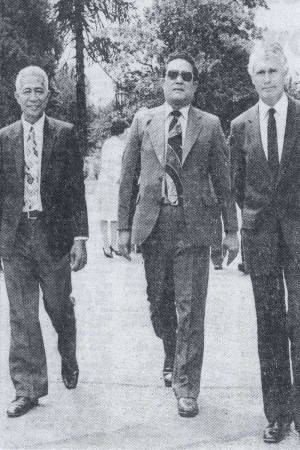
You are logged in as
Logout
You are logged in as
Logout
Regulus // Issue 2 // August 2023
 Memories of his time at St Andrew’s came flooding back for Dr Tabwe Bio (OC 1986) when he returned in January to show his family around the campus. “It brought back so many memories; the loneliness, the homesickness, the cultural shock, the difficulty in adjusting into a completely new culture and environment, the racial component of it (actually, that was the first time in my entire life to be conscious of my skin colour), the enjoyable academic challenges, the sport, the social gatherings, the outings and living with students’ whānau during term breaks. Looking back, I am so thankful to St Andrew’s College for these mixed exposures as they prepared me for my next even bigger challenge – university life and beyond.”
Memories of his time at St Andrew’s came flooding back for Dr Tabwe Bio (OC 1986) when he returned in January to show his family around the campus. “It brought back so many memories; the loneliness, the homesickness, the cultural shock, the difficulty in adjusting into a completely new culture and environment, the racial component of it (actually, that was the first time in my entire life to be conscious of my skin colour), the enjoyable academic challenges, the sport, the social gatherings, the outings and living with students’ whānau during term breaks. Looking back, I am so thankful to St Andrew’s College for these mixed exposures as they prepared me for my next even bigger challenge – university life and beyond.”
Tabwe spent two years as a boarder at St Andrew’s in the mid-1980s under the Island Territories Education Scheme, which provided opportunities for young Pacific Island students to attend educational institutions in New Zealand. After leaving the College, Tabwe became a GP based in Waikato. In May, he graduated with a Masters in Aviation Medicine and a Masters in Occupational Medicine.
In 1947, St Andrew’s was one of the first New Zealand schools to participate in the scheme, with many distinguished Old Collegians from the Pacific later passing through its gates. Despite English usually being a second language, many scholars went on to do well in both the classroom and on the sports field. A number later became prominent politicians, academics, and civil servants, both in New Zealand and in their motherlands.
One of the first two students in 1947 was George Schuster (OC 1951), from Apia in Samoa. He became a prefect in 1951 and captained the legendary 1st XV of that year, later becoming an orthopaedic surgeon and Samoa’s Director General of Health. Fellow Island scholar, Henry Naisali (OC 1952) went on to become Finance Secretary, Deputy Prime Minister, and Minster of Finance in Tuvalu, while another prefect that year, Sir Toaripi Lauti (OC 1951), became the first Prime Minister of Tuvalu and later, its Governor General.
Dr Tabwe Bio remembers being inspired by the 1985 visit to St Andrew’s by Sir Ieremia Tabai (OC 1969), who spoke to the students during an assembly. Sir Ieremia had been the first President of Kiribati from 1979–1982, taking office at the age of just 30, after being the youngest ever Minister of the Commonwealth Nations.
Another high achiever to attend St Andrew’s under the scheme was Feleti Teo (OC 1982), who was College Dux in 1982. He became the first Tuvaluan to qualify as a lawyer and was also the first Tuvaluan to serve as the country’s Attorney General and Head of Legal and Judicial Services.
Rector, Ian Galloway (1962–1982) and his wife Betty, had a special affection for the Pacific Island scholars. Many lived with the Galloways for a few days before school started and Betty would organise and label their linen and uniforms. In 1983, the Betty and Ian Galloway Scholarship was instituted to help boys from Kiribati and Tuvalu to attend St Andrew’s for their final two years of secondary school.
Today, St Andrew’s has a thriving cohort of Pasifika students, who continue on the proud legacy of those early scholars from the Pacific Islands.